Astrohistory
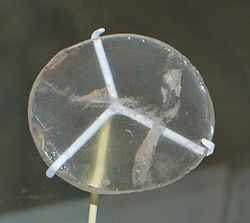
The Hominidae have apparently been on Earth for around seven million years, at least somewhere in Africa and possibly elsewhere. Fortunately and deliberately, many of these have worked out ways to record knowledge about the entities, sources, or objects in the sky.
Theoretical astrohistory
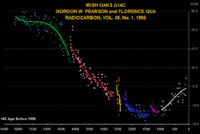

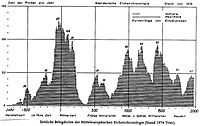
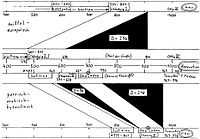
The history of looking at the sky from the surface of the Earth usually requires some way to verify that an entity, source, or object is from the past.
At right is an attempt to correlate the change in 14C with time before 1950. The different data sets are shown with different colored third order polynomial fits to each data set.
"The Δ14C values in a chronology can clearly be used to identify catastrophic gaps and catastrophic rises in carbon-14."[1]
The first four gaps have a jump up in 14C with a fairly quick return to the calibration curve shown in the figure on the left. However, from about 2000 b2k there is a steady rise in the Δ14C values.
"A proof-of-concept self-calibrating chronology [based upon the Irish Oak chronology] clearly demonstrates that third order polynomials provide a series of statistical calibration curves that highlight lacunae in the samples."[1]
As indicated in the figures, the data used in the plots comes from radiocarbon dating of Irish Oaks.[2]
Gaps occur near the 1070s and 1470s b2k during the rising Δ14C values.
"The number of suitable samples of wood, which connect Antiquity and the Middle Ages is very small [shown in the second figure on the right]. But only a great number of samples would give certainty against error. For the period about 380 AD we have only 3, for the period about 720 AD only 4 suitable samples of wood (Hollstein 1980,11); usually 50 samples serve for dating."[3]
"The center of the graph [in the third image on the right] shows the time axis of conventionally dated historical events. Upper and lower coordinates show reconstructed time tables. The black triangles mark the phantom years."[3]
"In Frankfurt am Main archaeological excavations did not find any layer for the period between 650 and 910 AD."[3]
Prehistory
The prehistory period dates from around 7 x 106 b2k to about 7,000 b2k.
Paleolithic
The paleolithic period dates from around 2.6 x 106 b2k to the end of the Pleistocene around 12,000 b2k.
"The Paleolithic ... extends from the earliest known use of stone tools, probably by hominins such as australopithecines, 2.6 million years ago, to the end of the Pleistocene around 10,000 [Before Present] BP [12,000 b2k].[4] The Paleolithic era is followed by the Mesolithic. The date of the Paleolithic—Mesolithic boundary may vary by locality as much as several thousand years."[5]
"Between 45,000 and 24,000 years ago [modern humans reached as far as 71° north latitude [at a site on the Yana River above the Arctic Circle in Siberia]."[6]
"There were three coastal techno-complexes: the Fosna along the coast of southern Norway, the Hensbacka in southwest Sweden near Bohuslän and the Komsa in northern Norway, all with a forerunner in the late Paleolithic Ahrensburg culture further south (Ibid. 74)."[6]
"By ca. 13,000 BP [13,000 b2k] long stretches of the Norwegian coast were ice-free but, as Hein Bjartmann Bjerck points out, there was “no certain evidence of human settlement in this rich arctic biotope” until near the end of the Younger Dryas (1,300 year cold snap) about 10,000 BP (2008: 65). The earliest evidence of human activity in Scandinavia is during the Early Mesolithic chronozone from 10,020-8,900 BP (9,500-8,000 cal BC); Bjerck lists 37 key sites in Norway (Ibid. 75-78)."[6]
Australian Aboriginal astronomy
"Australian Aboriginal astronomy is a name given to indigenous Australian culture relating to astronomical subjects — such as the Sun and Moon, the stars, planets, and the Milky Way, and their motions on the sky. Because the Australian Aboriginal culture is the oldest continuous culture in the world, it is probable that the Australian Aboriginal people are the world's oldest astronomers.[7]"[8]
Chinese astronomy
"At Damaidi in Ningxia, 3,172 cliff carvings dating to 6000–5000 BC [8,000 to 7,000 b2k] have been discovered, "featuring 8,453 individual characters such as the sun, moon, stars, gods and scenes of hunting or grazing." These pictographs are reputed to be similar to the earliest characters confirmed to be written Chinese.[9][10]"[11]
"[The Chinese] were the most persistent and accurate observers of celestial phenomena anywhere in the world before the Arabs."[12]
"Star names later categorized in the twenty-eight mansions have been found on oracle bones unearthed at Anyang, dating back to the middle Shang Dynasty (Chinese Bronze Age), and the mansion (xiù:宿) system's nucleus seems to have taken shape by the time of the ruler Wu Ding (1339-1281 BC, [3339-3281 b2k]).[13]"[14]
"It is believed that the first pretelescopic astronomers were the Chinese due to conclusive evidence such as the Gan Shi Xing Jing (the oldest recorded star catalog which was produced during the 5th century BCE)."[15]
Mesolithic
The mesolithic period dates from around 13,000 to 8,500 b2k.
The earliest traces of human settlement in Norway occur along the coast between 11,000 and 8,000 BC (13,000 to 10,000 b2k) during the Mesolithic, specifically the Younger Dryas period, include stone tools dated to between 11,000 b2k and 8,500 b2k.[16]
Ancient history
The ancient history period dates from around 8,000 to 3,000 b2k.
The modern scientific discipline of astronomy focuses on reproducibility and physical theory to explain and describe observations. Many ancient observers produced remarkably reproducible calendars such as the Mayan Long Count calendar which apparently goes from August 11, 3114 BCE, to October 13, 4772, and beyond.
"Ancient [astronomical] history is the aggregate of past [observed astronomical] events[17] from the beginning of recorded human history to the Early Middle Ages. The span of recorded history is roughly 5,000 years, with Sumerian Cuneiform script, the oldest discovered form of coherent writing, from the protoliterate period around the 30th century BC.[18]"[19]
And, on the telescope, there is this: "There are indeed ancient tablets that mention astronomers' lenses supported by a golden tube to enlarge the pupil, and in Nineveh a rock crystal lens was found (Pettinato 1998). Maybe one day a new archaeological excavation will find a Babylonian telescope for the first time."[20]
Egyptian astronomy
"Egyptian astronomy begins in prehistoric times, in the Predynastic Period. In the 5th millennium BCE [7,000 to 6,000 b2k], the stone circles at Nabta Playa may have made use of astronomical alignments. By the time the historical Dynastic Period began in the 3rd millennium BCE [5,000 to 4,000 b2k], the 365 day period of the Egyptian calendar was already in use, and the observation of stars was important in determining the annual flooding of the Nile. The Egyptian pyramids were carefully aligned towards the pole star, and the temple of Amun-Re at Karnak was aligned on the rising of the midwinter sun. Astronomy played a considerable part in fixing the dates of religious festivals and determining the hours of the night, and temple astrologers were especially adept at watching the stars and observing the conjunctions, phases, and risings of the Sun, Moon and planets."[21]
Mayan astronomy
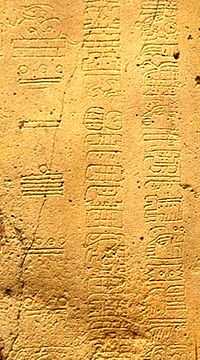
The Mayan Mesoamerican Long Count calendar apparently starts on August 11, 3114 BCE [5114 b2k].
"The Maya were keen astronomers and had mapped out the phases of celestial objects, especially the Moon and Venus. Many temples have doorways and other features aligning to celestial events. Round temples, often dedicated to Kukulcan, are perhaps those most often described as "observatories" by modern ruin tour-guides, but there is no evidence that they were so used exclusively, and temple pyramids of other shapes may well have been used for observation as well."[22]
"They produced extremely accurate astronomical observations; their charts of the movements of the moon and planets were used to predict eclipses and other celestial events such the time between conjunctions of Venus.[23] The accuracy of their astronomy and the "theoretical" calendar derived from it was superior to any other known from seventeen hundred years ago.[24][25]"[22]
"Uniquely, there is some evidence to suggest the Maya appear to be the only pre-telescopic civilization to demonstrate knowledge of the Orion Nebula as being fuzzy, i.e. not a stellar pin-point. The information which supports this theory comes from a folk tale that deals with the Orion constellation's area of the sky. Their traditional hearths include in their middle a smudge of glowing fire that corresponds with the Orion Nebula. This is a significant clue to support the idea that the Maya detected a diffuse area of the sky contrary to the pin points of stars before the telescope was invented.[26] Many preclassic sites are oriented with the Pleiades and Eta Draconis, as seen in La Blanca, Ujuxte, Monte Alto, and Takalik Abaj."[22]
"The Maya were very interested in zenial passages, the time when the sun passes directly overhead. The latitude of most of their cities being below the Tropic of Cancer, these zenial passages would occur twice a year equidistant from the solstice."[22]
"The Dresden Codex contains the highest concentration of astronomical phenomena observations and calculations of any of the surviving texts (it appears that the data in this codex is primarily or exclusively of an astronomical nature). Examination and analysis of this codex reveals that Venus was the most important astronomical object to the Maya, even more important to them than the sun."[22]
Hindu astronomy
5102 b2k, is the historical year assigned to a Hindu table of planets that does include the Sun, Mercury (or Hermes), "Hermès observait en -1660; donc les Indiens observaient en -3102, et ils observaient bien!", the Moon, Mars is mentioned, Jupiter, Saturn, but does not include Venus.[27] "Vénus seule ne s'y trouvait pas."[27] "Venus alone is not found there."[28]
Scandinavian astronomy
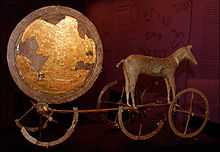
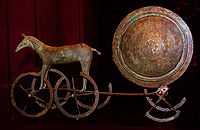
"The sculpture [imaged at left and right] is dated by the Nationalmuseet to about 1800 to 1600 BCE [3800 to 3600 b2k], though other dates have been suggested."[29]
"The occurrence of a supposedly Norse word (long-bata, i.e., longboat or ship) parallels other Norse words and personal names found on Celtiberian steles, and suggests that Norsemen were abroad long before the Viking age."[30]
Sumerian astronomy
"[M]any star names [in the earliest Babylonian star catalogues] appear in Sumerian [suggesting] a continuity reaching into the Early Bronze Age."[31]
"[T]he Sumerians ... developed the earliest writing system—known as cuneiform—around 3500–3200 BC. The Sumerians developed a form of astronomy that had an important influence on the sophisticated astronomy of the Babylonians."[31]
"Sumerian astronomers were the first to keep written records of what they learned about the heavens."[32] "A form of writing known as cuneiform emerged among the Sumerians around 3500–3000 BC [5500-5000 b2k]."[33]
Babylonian astronomy
"Old Babylonian astronomy refers to the astronomy that was practiced during and after the First Babylonian Dynasty (ca. 1830 BC) and before the Neo-Babylonian Empire (ca. 626 BC)."[31] Bold added.
"The Babylonians were the first to recognize that astronomical phenomena are periodic and apply mathematics to their predictions. Tablets dating back to the Old Babylonian period document the application of mathematics to the variation in the length of daylight over a solar year. Centuries of Babylonian observations of celestial phenomena are recorded in the series of cuneiform tablets known as the Enûma Anu Enlil—the oldest significant astronomical text that we possess is Tablet 63 of the Enûma Anu Enlil, the Venus tablet of Ammisaduqa, which lists the first and last visible risings of Venus over a period of about 21 years. It is the earliest evidence that planetary phenomena were recognized as periodic."[31]
"The MUL.APIN contains catalogues of stars and constellations as well as schemes for predicting heliacal risings and settings of the planets, and lengths of daylight as measured by a water clock, gnomon, shadows, and intercalations. The Babylonian GU text arranges stars in 'strings' that lie along declination circles and thus measure right-ascensions or time intervals, and also employs the stars of the zenith, which are also separated by given right-ascensional differences.[34] There are dozens of cuneiform Mesopotamian texts with real observations of eclipses, mainly from Babylonia."[31]
"[T]he earliest Babylonian star catalogues [date] from about 1200 BCE [3200 b2k]."[31]
~3000 b2k: “In the early first millennium BCE, Babylonian astronomers observed that the Sun's motion along the ecliptic was not uniform”[35].
"During the 8th and 7th centuries BCE, Babylonian astronomers developed a new empirical approach to astronomy. They began studying philosophy dealing with the ideal nature of the universe and began employing an internal logic within their predictive planetary systems. This was an important contribution to astronomy and the philosophy of science, and some scholars have thus referred to this new approach as the first scientific revolution.[36]"[31]
"Only fragments of Babylonian astronomy have survived, consisting largely of contemporary clay tablets with ephemerides and procedure texts, hence current knowledge of Babylonian planetary theory is in a fragmentary state.[37]"[31]
"[T]he first and highly successful attempt at giving a refined mathematical description of astronomical phenomena ... all subsequent varieties of scientific astronomy, in the Hellenistic world, in India, in Islam, and in the West—if not indeed all subsequent endeavour in the exact sciences—depend upon Babylonian astronomy in decisive and fundamental ways."[38]
Celtic astronomy
"Mercury was the most honoured of all the gods and many images of him were to be found. Mercury was regarded as the inventor of all the arts, the patron of travellers and of merchants, and the most powerful god in matters of commerce and gain. After him, the Gauls honoured Apollo, who drove away diseases, Mars, who controlled war, Jupiter, who ruled the heavens, and Minerva, who promoted handicrafts. He adds that the Gauls regarded Dis Pater as their ancestor.[39] ... [The names of Roman gods] are coupled with native Celtic theonyms and epithets, such as Mercury Visucius, Lenus Mars, Jupiter Poeninus, or Sulis Minerva."[40]
"Lugh probably meant a devotee of the Celtic god Lug (or Mercury, it is supposed)."[30]
Early history
The early history period dates from around 3,000 to 2,000 b2k.
"About 280 B.C. [2280 b2k], ... Aristarchus of Samos proposed the hypothesis that the Sun is at rest, while the Earth and the planets rotate about the Sun."[41] "Aristarchus also figured out how to measure the distances to the Sun and the Moon and their sizes."[42]
The celestial sphere may have been produced very early: "According to records, the first celestial globe was made by Geng Shou-chang (耿壽昌) between 70 BC and 50 BC. In the Ming Dynasty, the celestial globe at that time was a huge globe, showing the 28 mansions, celestial equator and ecliptic. None of them have survived."[14]
Classical history

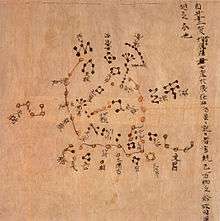
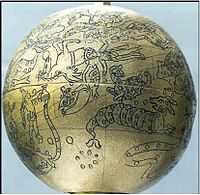
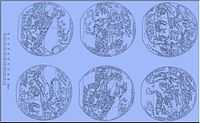
The classical history period dates from around 2,000 to 1,000 b2k.
The Dunhuang map from the Tang Dynasty of the North Polar region at right is thought to date from the reign of Emperor Zhongzong of Tang (705–710). Constellations of the three schools are distinguished with different colors: white, black and yellow for stars of Wu Xian, Gan De and Shi Shen respectively. The whole set of star maps contains 1,300 stars.
The Dunhuang Star Atlas, the last section of manuscript Or.8210/S.3326. It is "the oldest manuscript star atlas known today from any civilisation, probably dating from around AD 700. It shows a complete representation of the Chinese sky in 13 charts with over 1300 stars named and accurately presented."[43]
"The Dunhuang Star Atlas [above center] forms the second part of a longer scroll (Or.8210/S.3326) that measures 210 cm long by 24.4 cm wide and is made of fine paper in thirteen separate panels."[43]
"The first part of the scroll is a manual for divination based on the shape of clouds. The twelve charts showing different sections of the sky follow these. The stars are named and there is also explanatory text. The final chart is of the north-polar region. The chart is detailed, showing a total of 1345 stars in 257 clearly marked and named asterisms, or constellations, including all twenty-eight mansions."[43]
"The importance of the chart lies in both its accuracy and graphic quality. The chart includes both bright and faint stars, visible to the naked eye from north central China".[43]
The last known celestial globe shown at the right dates from 1850 to 1780 b2k. The constellation illustrations from the Mainz celestial globe are shown at the left.
Recent history
The recent history period dates from around 1,000 b2k to present.
The divisions of history for astronomy are sincerely based on the belief that the trained astronomers of today are different from the observers of antiquity. One fundamental differentiator is technology.
A big boon to visual astronomy is the telescope.
"The first known practical telescopes were invented in the Netherlands at the beginning of the 1600s (the 17th century), using glass lenses."[44]
Archeoastronomy

Today, astronomical history is usually divided into three parts: archaeoastronomy, historical astronomy, and the history of astronomy. These divisions are sincerely based on the belief that the trained astronomers of today are different from the observers of antiquity.
"Archaeoastronomy (also spelled archeoastronomy) is the study of how people in the past "have understood the phenomena in the sky how they used phenomena in the sky and what role the sky played in their cultures."[45] Clive Ruggles argues it is misleading to consider archaeoastronomy to be the study of ancient astronomy, as modern astronomy is a scientific discipline, while archaeoastronomy considers other cultures' symbolically rich cultural interpretations of phenomena in the sky.[46][47]"[48]
Historical astronomy
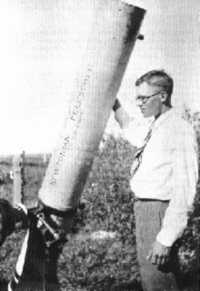
"Historical astronomy is the science of analysing historic astronomical data. The American Astronomical Society (AAS), established [in] 1899, states that its Historical Astronomy Division "...shall exist for the purpose of advancing interest in topics relating to the historical nature of astronomy. By historical astronomy we include the history of astronomy; what has come to be known as archaeoastronomy; and the application of historical records to modern astrophysical problems."[49] Historical and ancient observations are used to track theoretically long term trends, such as eclipse patterns and the velocity of nebular clouds.[50] Conversely, utilizing known and well documented phenomenological activity, historical astronomers ... apply computer models to verify the validity of ancient observations, as well as dating such observations and documents which would otherwise be unknown."[51]
History of astronomy
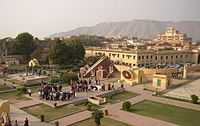
"Astronomy is the oldest of the natural sciences, dating back to antiquity, with its origins in the religious, mythological, and astrological practices of pre-history: vestiges of these are still found in astrology, a discipline long interwoven with public and governmental astronomy, and not completely disentangled from it until a few centuries ago in the Western World (see astrology and astronomy). In some cultures astronomical data was used for astrological prognostication. Ancient astronomers were able to differentiate between stars and planets, as stars remain relatively fixed over the centuries while planets will move an appreciable amount during a comparatively short time."[33]
Andromeda
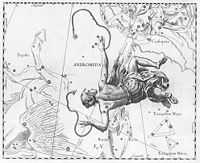
"Andromeda is one of the 48 constellations listed by the 2nd-century Greco-Roman astronomer Ptolemy [...] The uranography of Andromeda has its roots most firmly in the Greek tradition".[52]
"In Chinese astronomy, the stars that make up Andromeda were members of four different constellations that had astrological and mythological significance [...] In traditional Chinese astronomy, nine stars from Andromeda (including Beta Andromedae, Mu Andromedae, and Nu Andromedae), along with seven stars from Pisces, formed an elliptical constellation called "Legs"".[52]
A "constellation related to Andromeda also exists in Hindu mythology."[52]
A "female figure in Andromeda's location had appeared earlier in Babylonian astronomy. The stars that make up Pisces and the middle portion of modern Andromeda formed a constellation representing a fertility goddess, sometimes named as Anunitum or the Lady of the Heavens."[52]
"An Arab constellation called "al-Hut" (the fish) was composed of several stars in Andromeda, M31, and several stars in Pisces. [Nu Andromedae] ν And, [Mu Andromedae] μ And, [Beta Andromedae] β And, [Eta Andromedae] η And, [Zeta Andromedae] ζ And, [Epsilon Andromedae] ε And, [Delta Andromedae] δ And, [Pi Andromedae] π And, and [32 Andromedae] 32 And were all included from Andromeda; [Nu Piscium] ν Psc, [Phi Piscium] φ Psc, [Chi Piscium] χ Psc, and [Psi Piscium] ψ Psc were included from Pisces."[52]
"Andromeda is also associated with the Mesopotamian creation story of Tiamat, the goddess of Chaos. She bore many demons for her husband, Apsu, but eventually decided to destroy them in a war that ended when Marduk killed her. He used her body to create the constellations as markers of time for humans."[52]
"In the Marshall Islands, Andromeda, Cassiopeia, Triangulum, and Aries are incorporated into a constellation representing a porpoise. Andromeda's bright stars are mostly in the body of the porpoise; Cassiopeia represents its tail and Aries its head."[52]
"In the Tuamotu islands, Alpha Andromedae was called Takurua-e-te-tuki-hanga-ruki, meaning "Star of the wearisome toil""[52]
Andromeda is also in Urania's Mirror Plate 5 c. 1825.
Antlia
"One of the constellations of the southern sky introduced by Nicolas Louis de Lacaille on his map of 1756 to symbolize experimental physics. He originally called it la Machine Pneumatique [on the right] but Latinized this to Antlia Pneumatica on the second edition of the map published in 1763. Following a suggestion by John Herschel, the English astronomer Francis Baily shortened its name to just Antlia in his British Association Catalogue of 1845, and it has been known as that ever since."[53]
"The air pump [the second image down on the right is] shown as a complex piece of apparatus in the Uranographia of Johann Bode (1801)."[53]
The "most prominent stars that now comprise Antlia were once included within the ancient constellation Argo Navis, the Ship of the Argonauts, which due to its immense size was split into several smaller constellations by Lacaille in 1763.[54][55] However, given the faintness and obscurity of its stars, most authorities do not believe that the ancient Greeks included Antlia as part of their classical depiction of Argo Navis.[56]"[57]
"One Chinese constellation in this area, Dong’ou, is thought to have incorporated at least two stars of present-day Antlia, one of them being Iota Antliae; two or three other stars of Dong’ou were farther south in Vela. Dong’ou was named after a place in Zhejiang province, on the southeastern coast of China, where barbarians were said to live. Several more stars in western Antlia, including Epsilon, Eta and Theta, were part of Tianmiao, the celestial temple, most of which lay in Pyxis."[53]
Apus
"Apus is a faint constellation in the southern sky, first defined in the late 16th century."[58]
"Apus was one of twelve constellations created by Petrus Plancius from the observations of Pieter Dirkszoon Keyser and Frederick de Houtman and it first appeared on a 35 cm diameter celestial globe published in 1597 (or 1598) in Amsterdam by Plancius with Jodocus Hondius.[59][60] Plancius called the constellation "Paradysvogel Apis Indica"; the first word is Dutch for 'bird of paradise,' of genus Pteridophora, but the others are Latin for "Indian Bee," although "apis" (Latin for "bee") is presumably an error for "avis" or "bird".[60]"[58]
"After its introduction on Plancius's globe, the first known depiction of the constellation in a celestial atlas was in Johann Bayer's Uranometria of 1603, where it was called "Apis Indica".[60]"[58]
"When the Ming Dynasty Chinese astronomer Xu Guangqi adapted the European southern hemisphere constellations to the Chinese system in The Southern Asterisms, he combined Apus with some of the stars in Octans to form the "Exotic Bird" (異雀, Yìquè).[61]"[58]
Aquarius

"Aquarius is [...] one of the 48 constellations listed by the 2nd century AD astronomer Ptolemy [...] It is found in a region often called the Sea due to its profusion of constellations with watery associations such as Cetus the whale, Pisces the fish, and Eridanus the river.[62]"[63]
"In the first century CE, Ptolemy's Almagest established the common Western depiction of Aquarius. His water jar, an asterism itself, consists of Gamma, Pi, Eta, and Zeta Aquarii; it pours water in a stream of more than 20 stars terminating with Fomalhaut, now assigned solely to Piscis Austrinus. The water bearer's head is represented by 5th magnitude 25 Aquarii while his left shoulder is Beta Aquarii; his right shoulder and forearm are represented by Alpha and Gamma Aquarii respectively."[63]
"Aquarius is identified as GU.LA "The Great One" in the Babylonian star catalogues and represents the god Ea himself, who is commonly depicted holding an overflowing vase. The Babylonian star-figure appears on entitlement stones and cylinder seals from the second millennium. It contained the winter solstice in the Early Bronze Age.[64] In Old Babylonian astronomy, Ea was the ruler of the southernmost quarter of the Sun's path, the "Way of Ea", corresponding to the period of 45 days on either side of winter solstice. Aquarius was also associated with the destructive floods that the Babylonians regularly experienced, and thus was negatively connoted.[62] In Ancient Egypt, Aquarius was associated with the annual flood of the Nile; the banks were said to flood when Aquarius put his jar into the river, beginning spring.[65]"[63]
"In Greek mythology, Aquarius is sometimes associated with Deucalion, the son of Prometheus who built a ship with his wife Pyrrha to survive an imminent flood. They sailed for nine days before washing ashore on Mount Parnassus.[62][66] Aquarius is also sometimes identified with beautiful Ganymede, a youth in Greek mythology and the son of Trojan king Tros, who was taken to Mount Olympus by Zeus to act as cup-carrier to the gods.[67][59][66] Neighboring Aquila represents the eagle, under Zeus' command, that snatched the young boy;[68] some versions of the myth indicate that the eagle was in fact Zeus transformed. An alternative version of the tale recounts Ganymede's kidnapping by the goddess of the dawn, Eos, motivated by her affection for young men; Zeus then stole him from Eos and employed him as cup-bearer. Yet another figure associated with the water bearer is Cecrops I, a king of Athens who sacrificed water instead of wine to the gods.[66]"[63]
"In Chinese astronomy, the stream of water flowing from the Water Jar was depicted as the "Army of Yu-Lin" (Yu-lin-kiun or Yulinjun). The name "Yu-lin" means "feathers and forests", referring to the numerous light-footed soldiers from the northern reaches of the empire represented by these faint stars.[65][66] The constellation's stars were the most numerous of any Chinese constellation, numbering 45, the majority of which were located in modern Aquarius. The celestial army was protected by the wall Leibizhen, which counted Iota, Lambda, Phi, and Sigma Aquarii among its 12 stars.[66] 88, 89, and 98 Aquarii represent Fou-youe, the axes used as weapons and for hostage executions. Also in Aquarius is Loui-pi-tchin, the ramparts that stretch from 29 and 27 Piscium and 33 and 30 Aquarii through Phi, Lambda, Sigma, and Iota Aquarii to Delta, Gamma, Kappa, and Epsilon Capricorni.[65]"[63]
"Near the border with Cetus, the axe Fuyue was represented by three stars; its position is disputed and may have instead been located in Sculptor. Tienliecheng also has a disputed position; the 13-star castle replete with ramparts may have possessed Nu and Xi Aquarii but may instead have been located south in Piscis Austrinus. The Water Jar asterism was seen to the ancient Chinese as the tomb, Fenmu. Nearby, the emperors' mausoleum Xiuliang stood, demarcated by Kappa Aquarii and three other collinear stars. Ku ("crying") and Qi ("weeping"), each composed of two stars, were located in the same region.[66]"[63]
"Three of the Chinese lunar mansions shared their name with constellations. Nu, also the name for the 10th lunar mansion, was a handmaiden represented by Epsilon, Mu, 3, and 4 Aquarii. The 11th lunar mansion shared its name with the constellation Xu ("emptiness"), formed by Beta Aquarii and Alpha Equulei; it represented a bleak place associated with death and funerals. Wei, the rooftop and 12th lunar mansion, was a V-shaped constellation formed by Alpha Aquarii, Theta Pegasi, and Epsilon Pegasi; it shared its name with two other Chinese constellations, in modern-day Scorpius and Aries.[66]"[63]
Aquila

"The former constellation Antinous was merged into Aquilla in 1930, but both can be seen in this 1825 chart from Urania's Mirror."[69]
"Aquila was one of the 48 constellations described by the 2nd century astronomer Ptolemy. It had been earlier mentioned by Eudoxus in the 4th century BC and Aratus in the 3rd century BC."[69]
"The constellation was also known as Vultur volans (the flying vulture) to the Romans, not to be confused with Vultur cadens which was their name for Lyra. It is often held to represent the eagle who held Zeus's/Jupiter's thunderbolts in Greco-Roman mythology. Aquila is also associated with the eagle who kidnapped Ganymede, a son of one of the kings of Troy (associated with Aquarius), to Mount Olympus to serve as cup-bearer to the gods."[69]
"Ptolemy catalogued nineteen stars jointly in this constellation and in the now obsolete constellation of Antinous, which was named in the reign of the emperor Hadrian (AD 117–138), but sometimes erroneously attributed to Tycho Brahe, who catalogued twelve stars in Aquila and seven in Antinous. Hevelius determined twenty-three stars in the first[70] and nineteen in the second.[70]"[69]
"The Greek Aquila is probably based on the Babylonian constellation of the Eagle (MUL.A.MUSHEN), which is located in the same area as the Greek constellation.[71]"[69]
"In Greek mythology, Aquila is identified as the eagle that carried Zeus’ thunderbolts and was once dispatched by the god to carry Ganymede, the young Trojan boy Zeus desired, to Olympus to be the cup bearer of the gods."[72]
"In anothery story, the eagle is found guarding the arrow of Eros (represented by the constellation Sagitta), which hit Zeus and made him love-struck."[72]
"In yet another myth, Aquila represents Aphrodite disguised as an eagle, pretending to pursue Zeus in the form of a swan, so that Zeus’ love interest, the goddess Nemesis, would give him shelter. In the story, Zeus later placed the images of the eagle and the swan among the stars to commemorate the event."[72]
Ara
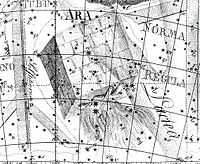
"Ara was one of the 48 Greek constellations described by the 2nd century astronomer Ptolemy"[73]
"In illustrations, Ara is usually depicted as an altar with its smoke 'rising' southward. However, depictions of Ara often vary in their details. In the early days of printing, a 1482 woodcut of Gaius Julius Hyginus's classic Poeticon Astronomicon depicts the altar as surrounded by demons.[74] Johann Bayer in 1603 depicted Ara as an altar with burning incense; the flames rise southward as in most atlases. Hyginus also depicted Ara as an altar with burning incense, though his Ara featured devils on either side of the flames. However, Willem Blaeu, a Dutch uranographer active in the 16th and 17th centuries, drew Ara as an altar designed for sacrifice, with a burning animal offering. Unlike most depictions, the smoke from Blaeu's Ara rises northward, represented by Alpha Arae. A more unusual depiction of Ara comes from Aratus, a Greek uranographer, in 270 BCE. He drew Ara as a lighthouse, where Alpha. Beta, Epsilon, and Zeta Arae represent the base, and Eta Arae represents the flames at the lighthouse's light.[75]"[73]
"In ancient Greek mythology, Ara was identified as the altar where the gods first made offerings and formed an alliance before defeating the Titans.[59] The nearby Milky Way represents the smoke rising from the offerings on the altar.[76]"[73]
"In Chinese astronomy, the stars of the constellation Ara lie within The Azure Dragon of the East (東方青龍, Dōng Fāng Qīng Lóng).[77]"[73]
Argo Navis
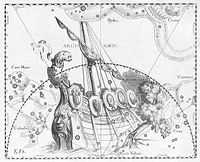
The view of Argo Navis in the image on the right is mirrored following the tradition of celestial globes, showing the celestial sphere in a view from "ouside".
"Argo Navis was a large southern constellation representing the ship used by Jason and the Argonauts. It is the only one of Ptolemy's list of 48 constellations which is no longer officially recognised as a constellation, having been broken up into Carina (the keel of the ship), Puppis (the poop) and Vela (the sails)."[78]
Aries

The constellation Aries is included on plate 16 of Sidney Hall's Urania's Mirror.
"In the Marshall Islands, [Aries is] incorporated into a constellation representing a porpoise. [...] Aries [represents] its head."[52]
"Three of the Chinese lunar mansions shared their name with constellations. [...] Wei, the rooftop and 12th lunar mansion, was a V-shaped constellation formed by Alpha Aquarii, Theta Pegasi, and Epsilon Pegasi; it shared its name with two other Chinese constellations, in modern-day Scorpius and Aries.[66]"[63]
Auriga

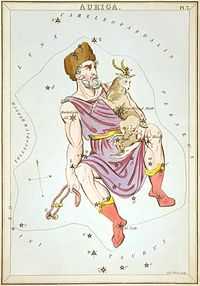
The constellation Auriga is centered on Card 7 of Sidney Hall's Urania's Mirror.
Boötes
"Boötes was one of the 48 constellations described by the 2nd century astronomer Ptolemy and is now one of the 88 modern constellations."[79]
"In ancient Babylon the stars of Boötes were known as SHU.PA. They were apparently depicted as the god Enlil, who was the leader of the Babylonian pantheon and special patron of farmers.[80]"[79]
Caelum
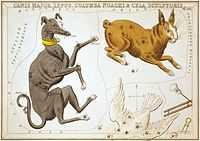
"Cela Sculptoris", Caelum, is in the lower right of this 1825 star chart from Sidney Hall's Urania's Mirror
Camelopardalis

Camelopardalis is depicted in plate 2 of Sidney Hall's Urania's Mirror.
Cancer
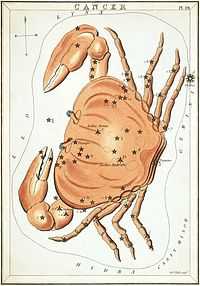
Cancer the crab occupies plate 19 on the right of Sidney Hall's Urania's Mirror.
Canes Venatici

Canes Venatici is depicted on plate 10 of Sidney Hall's Urania's Mirror.
Canis Major

Canis Major is depicted on the right in plate 30 of Sidney Hall's Urania's Mirror.
Canis Minor

In plate 31 of Sidney Hall's Urania's Mirror on the right is included Canis Minor.
Capricornus

Capricornus almost completely fills plate 25 of Sidney Hall's Urania's Mirror.
Carina

The view of Argo Navis in the image on the right is mirrored following the tradition of celestial globes, showing the celestial sphere in a view from "ouside".
"Argo Navis was a large southern constellation representing the ship used by Jason and the Argonauts. It is the only one of Ptolemy's list of 48 constellations which is no longer officially recognised as a constellation, having been broken up into Carina (the keel of the ship), Puppis (the poop) and Vela (the sails)."[78]
Cassiopeia
.jpg)
Cassiopeia occurs on plate 3 of Sidney Hall's Urania's Mirror.
"In the Marshall Islands, Andromeda, Cassiopeia, Triangulum, and Aries are incorporated into a constellation representing a porpoise. Andromeda's bright stars are mostly in the body of the porpoise; Cassiopeia represents its tail and Aries its head."[52]
"Bode in his catalogue Allgemeine Beschreibung und Nachweisung der Gestirne of 1801 assigned it 46 stars of 5th to 7th magnitude plus one deep-sky object, the galaxy NGC 1184. Most of these are now within the borders of northern Cepheus."[81]
"The Sami people of northern Scandinavia also visualized a reindeer called Sarvvis among the stars, but theirs was much bigger, incorporating Auriga, Perseus, Cassiopeia and Cepheus."[81]
Centaurus
.jpg)
In plate 32 from Sidney Hall's Urania's Mirror on the right, Centaurus is below Corvus to the left.
Cepheus
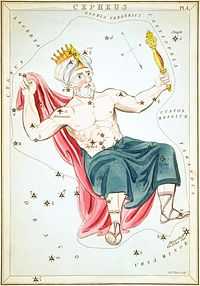
Cepheus is on plate 4 of Sidney Hall's Urania's Mirror.
"The Sami people of northern Scandinavia also visualized a reindeer called Sarvvis among the stars, but theirs was much bigger, incorporating Auriga, Perseus, Cassiopeia and Cepheus."[81]
Dong’ou
"One Chinese constellation in this area, Dong’ou, is thought to have incorporated at least two stars of present-day Antlia, one of them being Iota Antliae; two or three other stars of Dong’ou were farther south in Vela. Dong’ou was named after a place in Zhejiang province, on the southeastern coast of China, where barbarians were said to live."[53]
Eridanus
"Fluvius, the River [is a] name by which one of the constellations is called by some of the old writers; it is that which we characterise by the name of Eridanus."[82]
Felis
Felis was invented "in 1799 by the Frenchman Joseph Jérôme de Lalande (1732–1807) from stars between Antlia and Hydra."[83]
Gemini
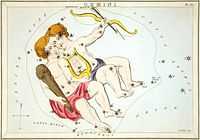
Gemini are shown on plate 18 of Sidney Hall's Urania's Mirror.
Hut
"An Arab constellation called "al-Hut" (the fish) was composed of several stars in Andromeda, M31, and several stars in Pisces. [Nu Andromedae] ν And, [Mu Andromedae] μ And, [Beta Andromedae] β And, [Eta Andromedae] η And, [Zeta Andromedae] ζ And, [Epsilon Andromedae] ε And, [Delta Andromedae] δ And, [Pi Andromedae] π And, and [32 Andromedae] 32 And were all included from Andromeda; [Nu Piscium] ν Psc, [Phi Piscium] φ Psc, [Chi Piscium] χ Psc, and [Psi Piscium] ψ Psc were included from Pisces."[52]
Legs
"In Chinese astronomy, the stars that make up Andromeda were members of four different constellations that had astrological and mythological significance [...] In traditional Chinese astronomy, nine stars from Andromeda (including Beta Andromedae, Mu Andromedae, and Nu Andromedae), along with seven stars from Pisces, formed an elliptical constellation called "Legs"".[52]
Libra
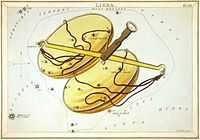
Libra is displayed on plate 22.
Musca

The constellation of Musca Borealis are included on plate 16 of Sidney Hall's Urania's Mirror.
Orion
.jpg)
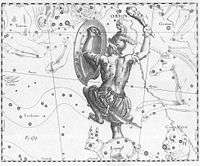
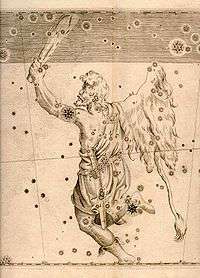
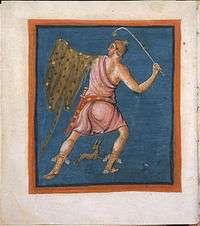
The plate 29 in Urania's Mirror, a set of celestial cards accompanied by A familiar treatise on astronomy, on the left is by Sidney Hall of Orion with a killed lion from 1825.
The first image on the right is an "outside" view of Orion from 1690 by Johannes Hevelius from Prodromus Astronomia, volume III: Firmamentum Sobiescianum, sive Uranographia.
The second image on the left is a print of the copperplate engraving for Johann Bayer's Uranometria (1661) showing the constellation Orion with Betelgeuse in his left shoulder.
The version of Orion in the second image down on the right with Lepus originated between circa 830 and circa 840 and is from the Leiden University Library Website.
Pisces

Pisces is on plate 27 of Sidney Hall's Urania's Mirror.
Quadrans Muralis

"Quadrans Muralis occupied what is now the northern part of Boötes, near the end of the Plough’s handle (or, alternatively, the tip of the Great Bear’s tail)."[84]
"The constellation was invented by the French astronomer Joseph Jérôme de Lalande (1732–1807) to commemorate the wall-mounted quadrant that he and his nephew Michel Lefrançois de Lalande (1766–1839) used for measuring star positions (‘muralis’ is Latin for ‘wall’)."[84]
It is depicted on the right in plate 10 of Sidney Hall's Urania's Mirror.
Rangifer
Rangifer is a "faint constellation of the far north introduced in 1743 on a star chart published by the Frenchman Pierre-Charles Le Monnier (1715–1799) in his book La Théorie des Comètes."[81]
"It has also been known by the name Tarandus, from the reindeer’s scientific name, Rangifer tarandus."[81]
"Bode in his catalogue Allgemeine Beschreibung und Nachweisung der Gestirne of 1801 assigned it 46 stars of 5th to 7th magnitude plus one deep-sky object, the galaxy NGC 1184. Most of these are now within the borders of northern Cepheus."[81]
Sarvvis
"The Sami people of northern Scandinavia also visualized a reindeer called Sarvvis among the stars, but theirs was much bigger, incorporating Auriga, Perseus, Cassiopeia and Cepheus."[81]
Scorpius
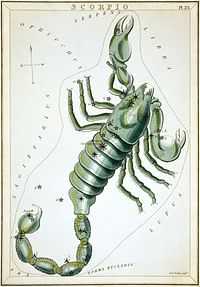
The scorpion Scorpio is on plate 23 of Sidney Hall's Urania's Mirror.
Scutum
Scutum, or Scutum Sobiesky, apparently the same asterism is included in Urania's Mirror under section Plate 12.
Taurus
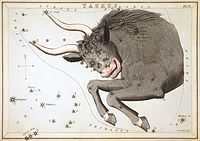
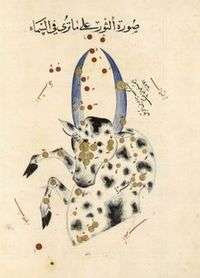
Only the front half of Taurus is included on plate 17 of Sidney Hall's Urania's Mirror on the right.
On the left Taurus is depicted in the astronomical treatise Book of Fixed Stars by the Persian astronomer Abd al-Rahman al-Sufi, c. 964.
Telescopium

Sagittarius and Corona Australis, Microscopium, and Telescopium are on plate 24.
Telescopium Hershelii

Lynx and Telescopium Herschilii are on plate 8.
Tianmiao
"Several more stars in western Antlia, including Epsilon, Eta and Theta, were part of Tianmiao, the celestial temple, most of which lay in Pyxis."[53]
Triangulum
"In the Marshall Islands, Andromeda, Cassiopeia, Triangulum, and Aries are incorporated into a constellation representing a porpoise. Andromeda's bright stars are mostly in the body of the porpoise; Cassiopeia represents its tail and Aries its head."[52]
Triangulum Australe
Triangulum Australe is one "of the 12 constellations introduced at the end of the 16th century by the Dutch navigators Pieter Dirkszoon Keyser and Frederick de Houtman, and the smallest of them according to modern boundaries."[85]
Tucana
Tucana is one "of the 12 southern constellations devised by the Dutch navigators Pieter Dirkszoon Keyser and Frederick de Houtman at the end of the 16th century. It represents the South American bird with a huge bill."[86]
Ursa Major

Ursa Major is on plate 9 of Sidney Hall's Urania's Mirror.
Ursa Minor

Plate 1 of Sidney Hall's Urania's Mirror depicts the constellation Ursa Minor.
Vela

"Argo Navis was a large southern constellation representing the ship used by Jason and the Argonauts. It is the only one of Ptolemy's list of 48 constellations which is no longer officially recognised as a constellation, having been broken up into Carina (the keel of the ship), Puppis (the poop) and Vela (the sails)."[78]
Virgo

Virgo is the only constellation depicted on plate 21 of Sidney Hall's Urania's Mirror.
Volans
Volans is one "of the 12 new constellations introduced at the end of the 16th century by the Dutch navigators Pieter Dirkszoon Keyser and Frederick de Houtman."[87]
"The constellation was first depicted in 1598 on a globe by the Dutchman Petrus Plancius under the name Vliegendenvis. Bayer in 1603 called it Piscis Volans, the Latin title by which it became generally known until the mid 19th century. In 1844 the English astronomer John Herschel proposed shortening it to just Volans. Francis Baily adopted this suggestion in his British Association Catalogue of 1845, and it has been known as that ever since."[87]
Vulpecula


"Johannes Hevelius created “Vulpecula cum Ansere” (the Little Fox with the Goose) [image on the right] out of unformed stars in the space between Cygnus and Aquila. The constellation first appeared in Firmamentum Sobiescianum sive Uranographia (1687) and the accompanying introductory text, Prodromus astronomiae (1690). "[88]
"In atlases published before Hevelius, its stars are shown simply marking the flow of the Milky Way through the area."[88]
“Hevelius placed the fox near two other hunting animals, the eagle (the constellation Aquila) and the vulture (which was an alternative identification for Lyra). He explained that the fox was taking the goose to neighbouring Cerberus, another of his inventions.”[66]
"Richard Hinckley Allen (1899) put the total number of constituent stars identified by Hevelius at 27, while the German astronomers Friedrich Argelander (1843) and Eduard Heis (1872) recorded 37 and 62 stars, respectively, in their later catalogs."[88]
"Vulpecula, the fox, carries a goose, Anser, towards the multi-headed monster Cerberus in this illustration from the Firmamentum Sobiescianum star atlas of Johannes Hevelius published in 1690."[89]
"Hevelius drew his constellations in reverse, as they would be seen on a celestial globe, [from outside] so here the goose is to the left of the fox."[89]
The second image down on the right is plate 14 of Sidney Hall's Urania's Mirror. It depicts Lacerta, Cygnus, Lyra, Vulpecula and Anser.
Urania's Mirror plate 1

Plate 1 has the constellations Draco and Ursa Minor.
Plate 2

Camelopardalis, Tarandus and Custos Messium are on plate 2.
Plate 5

Card 5, or plate 5, shows Andromeda and Triangula, plus the obsolete constellation Gloria Frederici at the upper left.
Plate 6
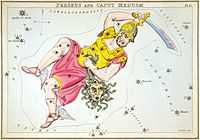
Perseus and Caput Medusae are on plate 6.
Plate 8

Lynx and Telescopium Herschilii are on plate 8.
Plate 10

The image at the right is "Boötes as depicted in Urania's Mirror, a set of constellation cards published in London c.1825. In his left hand he holds his hunting dogs, Canes Venatici. Below them is the constellation Coma Berenices. Above the head of Boötes is Quadrans Muralis, now obsolete, but which lives on as the name of the early January Quadrantid meteor shower. Mons Mænalus can be seen at his feet."[79]
Plate 11

Hercules, Cerberus, and Corona Borealis are on plate 11.
Plate 12

Taurus Poniatowski, Serpentarius (Ophiuchus), Scutum Sobieski, and Serpens are on plate 12.
Plate 13

Plate 13, or card 13, depicts Delphinus, Sagitta, Aquila, and Antinous (now obsolete).
Plate 14

Lacerta, Cygnus, Lyra, Vulpecula and Anser are depicted on plate 14 of Sidney Hall's Urania's Mirror.
"Johannes Hevelius created “Vulpecula cum Ansere” (the Little Fox with the Goose) out of unformed stars in the space between Cygnus and Aquila. The constellation first appeared in Firmamentum Sobiescianum sive Uranographia (1687) and the accompanying introductory text, Prodromus astronomiae (1690). "[88]
"In atlases published before Hevelius, its stars are shown simply marking the flow of the Milky Way through the area."[88]
“Hevelius placed the fox near two other hunting animals, the eagle (the constellation Aquila) and the vulture (which was an alternative identification for Lyra). He explained that the fox was taking the goose to neighbouring Cerberus, another of his inventions.”[66]
"Richard Hinckley Allen (1899) put the total number of constituent stars identified by Hevelius at 27, while the German astronomers Friedrich Argelander (1843) and Eduard Heis (1872) recorded 37 and 62 stars, respectively, in their later catalogs."[88]
Plate 15
.jpg)
Pegasus and Equuleus are on plate 15.
Plate 20

Plate 20 includes Leo Major and Leo Minor.
Plate 24

Sagittarius and Corona Australis, Microscopium, and Telescopium are on plate 24.
Plate 26

Aquarius, Piscis Australis & Ballon Aerostatique are included on plate 26.
Plate 28

Psalterium Georgii, Fluvius Eridanus, Cetus, Officina Sculptoris, Fornax Chemica, and Machina Electrica are included on plate 28.
Urania's Mirror plate 30

Plate 30 shows Canis Major, Lepus, Columba Noachi and Cela Sculptoris (Caelum).
Plate 31

Plate 31 has the constellations Atelier Typographique, Canis Minor, and Monoceros.
Urania's Mirror plate 32
.jpg)
Hydra is the longest constellation stretching across the card. Corvus is the gray-black bird near the end of Hydra's tail on the left. Crater is the gold cup just to the right and above Corvus. Sextans is directly behind the head of Hydra. Centaurus is below Corvus to the left. Lupus is to the left of Centaurus. Antlia is below Hydra and to the right of Hydra's major curve. Pyxis the compass overlies the mast of Argo Navis. Puppis is the deck of Argo Navis.
Argo Navis, Noctua (the owl), and Felis the cat are obsolete constellations.
Io
"Io and Europa were seen for the first time as separate bodies during Galileo's observations of the Jupiter system the following day, January 8, 1610 (used as the discovery date for Io by the IAU).[90] The discovery of Io and the other Galilean satellites of Jupiter was published in Galileo's Sidereus Nuncius in March 1610.[91]"[92]
Sciences
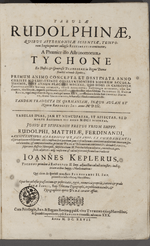
The image at right shows the title page of Johannes Kepler's Rudolphine Tables dating from 1627. It is regarded as the most accurate and comprehensive star catalogue and planetary tables published up until that time. It contained the positions of over 1000 stars and directions for locating the planets within our solar system. Kepler finished the work in 1623 and dedicated it to his patron, the Emperor Rudolf II, but actually published it in 1627. The table's findings support Kepler's laws and the theory of a heliocentric astronomy.
Technology
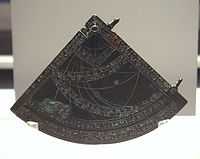
"Technology is the making, usage, and knowledge of tools, machines, techniques, crafts, systems or methods of organization in order to solve a problem or perform a specific function. It can also refer to the collection of such tools, machinery, and procedures."[93]
Refracting telescope
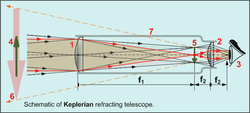
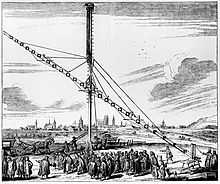
The early telescopes as manufactured in the Netherlands are refracting. "The first known practical telescopes were invented in the Netherlands at the beginning of the 17th century, using glass lenses."[44]
"The earliest recorded working telescopes were the refracting telescopes that appeared in the Netherlands in 1608. Their development is credited to three individuals: Hans Lippershey and Zacharias Janssen, who were spectacle makers in Middelburg, and Jacob Metius of Alkmaar.[94] "The Hague discussed the patent applications first of Hans Lipperhey of Middelburg, and then of Jacob Metius of Alkmaar... another citizen of Middelburg, Sacharias Janssen had a telescope at about the same time but was at the Frankfurt Fair where he tried to sell it"."[44]
"The Keplerian Telescope, invented by Johannes Kepler in 1611, is an improvement on Galileo's design.[95] It uses a [plano]convex lens as the eyepiece instead of Galileo's [double] concave one. The advantage of this arrangement is [that] the rays of light emerging from the eyepiece are converging. This allows for a much wider field of view and greater eye relief but the image for the viewer is inverted. ... All refracting telescopes use the same principles. The combination of an objective lens 1 and some type of eyepiece 2 is used to gather more light than the human eye could collect on its own, focus it 5, and present the viewer with a brighter, clearer, and magnified virtual image 6."[96]
Clocks

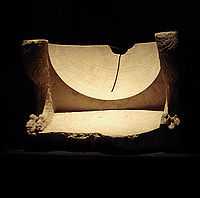
"[T]he earliest known sundial [is] from an Egyptian burial dated in the fifteenth century B.C. Sometimes called a shadow clock, or an L-board because of its shape [with] relatively crude performance."[97] A "[f]ragment of a late Egyptian sundial [from] about 3000 B.C." exists.[97]
Computers
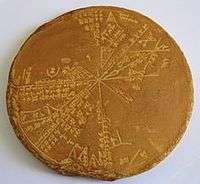
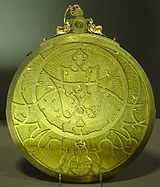
The image at upper right is of an astrolabe quadrant at the British Museum from England as of 1388.
"[T]he astrolabe was effectively an analog calculator capable of working out several different kinds of problems in spherical astronomy."[98]
Some form of an "astrolabe" may have been in use by the third millennium BC.[99]
The image on the right is a reproduction of a Sumerian star map or “planisphere” recovered in the late 19th century from the 650 BCE underground library of Ashurbanipal. It is also called an astrolabe.
Printing

"The invention of the printing press (an early example is shown at right) made it possible for scientists and politicians to communicate their ideas with ease, leading to the Age of Enlightenment; an example of technology as a cultural force."[93]
Research
Hypothesis:
- Each of the various forms of the history of astronomy can all be included in astrohistory.
Control groups

The findings demonstrate a statistically systematic change from the status quo or the control group.
“In the design of experiments, treatments [or special properties or characteristics] are applied to [or observed in] experimental units in the treatment group(s).[100] In comparative experiments, members of the complementary group, the control group, receive either no treatment or a standard treatment.[101]"[102]
Proof of concept
Def. a “short and/or incomplete realization of a certain method or idea to demonstrate its feasibility"[103] is called a proof of concept.
Def. evidence that demonstrates that a concept is possible is called proof of concept.
The proof-of-concept structure consists of
- background,
- procedures,
- findings, and
- interpretation.[104]
See also
References
- 1 2 Gunnar Heinsohn (8 September 2014). "A Carbon-14 Chronology". Wordpress.com: Malaga Bay. Retrieved 2014-10-25.
- ↑ Gordon W. Pearson and Florence Qua (1993). "High-Precision 14C Measurement of Irish Oaks to Show the Natural 14C Variations from AD 1840-5000 BC: A Correction". Radiocarbon 35 (1): -24. https://journals.uair.arizona.edu/index.php/radiocarbon/article/viewFile/18069/17799#page=110. Retrieved 2014-10-25.
- 1 2 3 Hans-Ulrich Niemitz (03 April 2000). "Did the Early Middle Ages Really Exist?". Cambridge, UK: Cambridge University. Retrieved 2014-10-26.
- ↑ Toth, Nicholas; Schick, Kathy (2007). "21 Overview of Paleolithic Archaeology". In Henke, H.C. Winfried; Hardt, Thorolf; Tattersall, Ian. Handbook of Paleoanthropology. Volume 3. Berlin; Heidelberg; New York: Springer-Verlag. p. 1944. ISBN 978-3-540-32474-4 (Print); 978-3-540-33761-4 (Online). http://www.springerlink.com/content/u68378621542472j/.
- ↑ "Paleolithic, In: Wikipedia". San Francisco, California: Wikimedia Foundation, Inc. June 24, 2013. Retrieved 2013-06-26.
- 1 2 3 John Weinstock (Fall 2009). "Paleolithic Settlement in Eurasia". University of Texas. Retrieved 2013-06-26.
- ↑ (1 November 2009). Before Galileo. Ray Norris. Message Stick.
- ↑ "Australian Aboriginal astronomy, In: Wikipedia". San Francisco, California: Wikimedia Foundation, Inc. April 22, 2013. Retrieved 2013-06-27.
- ↑ "Chinese writing '8,000 years old'". BBC News. 18 May 2007. Retrieved 2010-05-04.
- ↑ "Carvings may rewrite history of Chinese characters". Xinhua online. 18 May 2007. Retrieved 2007-05-19.
- ↑ "History of China, In: Wikipedia". San Francisco, California: Wikimedia Foundation, Inc. June 25, 2013. Retrieved 2013-06-27.
- ↑ Needham, Volume 3, p.171
- ↑ Needham, Volume 3, p.242
- 1 2 "Chinese astronomy, In: Wikipedia". San Francisco, California: Wikimedia Foundation, Inc. May 20, 2013. Retrieved 2013-06-25.
- ↑ "Pretelescopic astronomy, In: Wikipedia". San Francisco, California: Wikimedia Foundation, Inc. March 19, 2013. Retrieved 2013-06-25.
- ↑ "Norge, In: Wikipedia". San Francisco, California: Wikimedia Foundation, Inc. June 20, 2013. Retrieved 2013-06-26.
- ↑ WordNet Search - 3.0, "History"
- ↑ see Jemdet Nasr period, Kish tablet; see also The Origin and Development of the Cuneiform System of Writing, Samuel Noah Kramer, Thirty Nine Firsts In Recorded History, pp 381-383
- ↑ "Ancient history, In: Wikipedia". San Francisco, California: Wikimedia Foundation, Inc. June 27, 2013. Retrieved 2013-06-27.
- ↑ Giulio Magli (2009). When the method is lacking, In: Mysteries and Discoveries of Archaeoastronomy from Giza to Easter Island. Rome, Italy: Copernicus Books. pp. 97-116. doi:10.1007/978-0-387-76566-2_5. ISBN 978-0-387-76564-8. http://www.springerlink.com/content/w2q6g0q252221k0u/fulltext.pdf. Retrieved 2011-10-15.
- ↑ "Egyptian astronomy, In: Wikipedia". San Francisco, California: Wikimedia Foundation, Inc. June 7, 2013. Retrieved 2013-06-27.
- 1 2 3 4 5 "Maya civilization, In: Wikipedia". San Francisco, California: Wikimedia Foundation, Inc. June 23, 2013. Retrieved 2013-06-27.
- ↑ Thompson, J. Eric S., 1974 "Maya Astronomy" recoverable at: http://www.jstor.org/discover/10.2307/74276?uid=3738584&uid=2&uid=4&sid=21101585154047, accessed 2012.12.22
- ↑ Smiley, C. H., 1960, "The Antiquity and Precision of Mayan Astronomy" viewable at 222–223 and 226 http://articles.adsabs.harvard.edu//full/1960JRASC..54..222S/0000226.000.html, accessed 2012.12.22
- ↑ Rice, Tony (2012-12-21). "Mayan calculations hold up, to a point". WRAL.com. Retrieved 2013-03-26.
- ↑ As interpreted by Krupp 1999.
- 1 2 Jean Baptiste Joseph Delambre (1817). Histoire de l'astronomie ancienne. Paris: Courcier. pp. 639. http://books.google.com/books?id=2lVUjJSxjhQC&pg=PR3&dq=%22Histoire+de+l'astronomie+ancienne%22,+Volume+1&source=gbs_selected_pages&cad=3#v=onepage&q=%22Histoire%20de%20l'astronomie%20ancienne%22%2C%20Volume%201&f=false. Retrieved 2012-01-13.
- ↑ Immanuel Velikovsky (January 1965). Worlds in Collision. New York: Dell Publishing Co., Inc.. pp. 401. http://books.google.com/books?id=FJst27kSVBgC&pg=PA13&hl=en. Retrieved 2012-01-13.
- ↑ "Trundholm sun chariot, In: Wikipedia". San Francisco, California: Wikimedia Foundation, Inc. May 23, 2013. Retrieved 2013-06-26.
- 1 2 Barry Fell (1978). America B.C.: ancient settlers in the New World. Pocket Books. pp. 312. ISBN 067179079X. http://books.google.com/books?ei=4HXMUYy7EcbwiwK90oHgBw&id=eX8m52WeJj0C&q=Norse#search_anchor. Retrieved 2013-06-27.
- 1 2 3 4 5 6 7 8 "Babylonian astronmy, In: Wikipedia". San Francisco, California: Wikimedia Foundation, Inc. June 19, 2013. Retrieved 2013-06-26.
- ↑ Betsy Maestro (2004). The Story of Clocks and Calendars. New York: HarperCollins. pp. 48. ISBN 0-688-14548-5.
- 1 2 "History of astronomy, In: Wikipedia". San Francisco, California: Wikimedia Foundation, Inc. June 7, 2012. Retrieved 2012-06-16.
- ↑ Pingree (1998)
Rochberg (2004)
Evans (1998) - ↑ "Sun, In: Wikipedia". San Francisco, California: Wikimedia Foundation, Inc. September 19, 2012. Retrieved 2012-09-19.
- ↑ D. Brown (2000), Mesopotamian Planetary Astronomy-Astrology, Styx Publications, ISBN 90-5693-036-2.
- ↑ Asger Aaboe (1958). "On Babylonian Planetary Theories". Centaurus 5 (3–4): 209–77.
- ↑ A. Aaboe (May 2, 1974). "Scientific Astronomy in Antiquity". Philosophical Transactions of the Royal Society 276 (1257): 21–42. doi:10.1098/rsta.1974.0007.
- ↑ Julius Caesar, Commentarii de Bello Gallico 6:17-18
- ↑ "Celtic pantheon, In: Wikipedia". San Francisco, California: Wikimedia Foundation, Inc. 27 June 2013. Retrieved 2013-06-27.
- ↑ B. L. van der Waerden (1974). "The Earliest Form of the Epicycle Theory". Journal for the History of Astronomy 5: 175-85. http://adsabs.harvard.edu//abs/1974JHA.....5..175V. Retrieved 2011-10-26.
- ↑ D. Koutsoyiannis and A. N. Angelakis (2003). Hydrologic and Hydraulic Science and Technology in Ancient Greece, In: Encyclopedia of Water Science. New York: Marcel Dekker, Inc.. pp. 415-7. doi:10.1081/E-EWS 120016393. http://www.a-angelakis.gr/files/books/2002Encycl2WatResTechAncGreEntry2.pdf. Retrieved 2011-10-26.
- 1 2 3 4 British Library (June 2015). "The Dunhuang Star Atlas". British Library: International Dunhuang Project (IDP). Retrieved 2015-12-27.
- 1 2 3 "Telescope, In: Wikipedia". San Francisco, California: Wikimedia Foundation, Inc. September 14, 2012. Retrieved 2012-09-17.
- ↑ Sinclair, R.M. (2006). "The Nature of Archaeoastronomy". In Todd W. Bostwick and Bryan Bates. Viewing the Sky Through Past and Present Cultures; Selected Papers from the Oxford VII International Conference on Archaeoastronomy. Pueblo Grande Museum Anthropological Papers. 15. City of Phoenix Parks and Recreation Department. pp. 13–26. ISBN 1-882572-38-6.
- ↑ Ruggles, C.L.N. (2005). Ancient Astronomy. ABC-Clio. ISBN 1-85109-477-6.
- ↑ Ruggles, C.L.N. (1999). Astronomy in Prehistoric Britain and Ireland. Yale University Press. ISBN 0-300-07814-5.
- ↑ "Archaeoastronomy, In: Wikipedia". San Francisco, California: Wikimedia Foundation, Inc. June 14, 2012. Retrieved 2012-06-16.
- ↑
- ↑
- ↑ "Historical astronomy, In: Wikipedia". San Francisco, California: Wikimedia Foundation, Inc. October 28, 2011. Retrieved 2012-06-16.
- 1 2 3 4 5 6 7 8 9 10 11 12 13 "Andromeda (constellation), In: Wikipedia". San Francisco, California: Wikimedia Foundation, Inc. May 13, 2014. Retrieved 2014-05-13.
- 1 2 3 4 5 Ian Ridpath (19 January 2016). "Antlia The air pump". Ian Ridpath. Retrieved 2016-01-19.
- ↑ Peter Birren (2002) Objects in the Heavens, pp. 9, 45 (ISBN 155369662X).
- ↑ Thomas William Webb (Dover Publications 1962) Celestial objects for common telescopes, Volume 2, p. 36.
- ↑ Ian Ridpath (2002) Stars and Planets, pp, 65, 122. (ISBN 0-7894-8988-0)
- ↑ "Antlia, In: Wikipedia". San Francisco, California: Wikimedia Foundation, Inc. 26 October 2014. Retrieved 2014-10-26.
- 1 2 3 4 "Apus, In: Wikipedia". San Francisco, California: Wikimedia Foundation, Inc. April 2, 2014. Retrieved 2014-05-30.
- 1 2 3 Ridpath, Ian (2001), Stars and Planets Guide, Princeton University Press, ISBN 0-691-08913-2
- 1 2 3 Tammy Plotner (13 October 2008). "Apus". Universe Today. Retrieved 22 April 2012.
- ↑ AEEA (Activities of Exhibition and Education in Astronomy) 天文教育資訊網 2006 年 7 月 29 日
- 1 2 3 Thompson, Robert Bruce; Thompson, Barbara Fritchman (2007), Illustrated Guide to Astronomical Wonders, O'Reilly Media, ISBN 978-0-596-52685-6
- 1 2 3 4 5 6 7 8 "Aquarius, In: Wikipedia". San Francisco, California: Wikimedia Foundation, Inc. April 2, 2014. Retrieved 2014-05-30.
- ↑ Hugh Thurston (1996). Early Astronomy. Springer. ISBN 978-0-387-94822-5.
- 1 2 3 Julius D.W. Staal (1988). The New Patterns in the Sky: Myths and Legends of the Stars (2nd ed.). The McDonald and Woodward Publishing Company. ISBN 0-939923-04-1.
- 1 2 3 4 5 6 7 8 9 10 Ian Ridpath (1989). Anser, In: The Lost Constellations. Springer/Praxis Books, Springer International Publishing. pp. 35-45. ISBN 978-3-319-22794-8. http://link.springer.com/chapter/10.1007/978-3-319-22795-5_3. Retrieved 2015-12-13.
- ↑ Patrick Moore (2000). The Data Book of Astronomy. Institute of Physics Publishing. ISBN 0-7503-0620-3.
- ↑ John H. Rogers (1998). "Origins of the ancient constellations: II. The Mediterranean traditions". Journal of the British Astronomical Association 108 (2): 79–89. http://articles.adsabs.harvard.edu/cgi-bin/nph-iarticle_query?1998JBAA..108...79R&data_type=PDF_HIGH&whole_paper=YES&type=PRINTER&filetype=.pdf.
- 1 2 3 4 5 "Aquila (constellation), In: Wikipedia". San Francisco, California: Wikimedia Foundation, Inc. 26 October 2014. Retrieved 2014-10-26.
- 1 2 "Prodromus astronomiae". 1690. pp. 272–273.
- ↑ Gavin White (2008). Babylonian Star-lore. Solaria Pubs.
- 1 2 3 Constellation-Guide (18 July 2014). "Aquila Constellation". Constellation-Guide. Retrieved 2014-07-18.
- 1 2 3 4 "Ara (constellation), In: Wikipedia". San Francisco, California: Wikimedia Foundation, Inc. 11 October 2014. Retrieved 2014-10-28.
- ↑ Kanas, Nick (2012). History, Artistry, and Cartography (Second Edition). Chichester, U.K.: Praxis Publishing. p. 136. ISBN 978-1-4614-0916-8. http://link.springer.com/book/10.1007%2F978-1-4614-0917-5.
- ↑ Staal 1988, p. 230.
- ↑ Staal 1988, p. 229.
- ↑ AEEA 2006.
- 1 2 3 "Boötes, In: Wikipedia". San Francisco, California: Wikimedia Foundation, Inc. 11 October 2014. Retrieved 2013-10-30.
- ↑ White 2008, p. 207.
- 1 2 3 4 5 6 7 Ian Ridpath (19 January 2016). "Rangifer The reindeer". Ian Ridpath. Retrieved 2016-01-19.
- ↑ John Hill (1754). Urania: Or, a Compleat View of the Heavens; Containing the Antient and Modern Astronomy, in Form of a Dictionary: Illustrated with a Great Number of Figures ... A Work Intended for General Use, Intelligible to All Capacities, and Calculated for Entertainment as Well as Instruction. London: T. Gardner. pp. 620. http://books.google.co.uk/books?id=lzigAAAAMAAJ&source=gbs_navlinks_s. Retrieved 2014-11-02.
- ↑ Ian Ridpath (19 January 2015). "Felis The cat". Ian Ridpath. Retrieved 2016-01-19.
- 1 2 Ian Ridpath (19 January 2016). "Quadrans Muralis The mural quadrant". Ian Ridpath. Retrieved 2016-01-19.
- ↑ Ian Ridpath (19 January 2016). "Triangulum Australe The southern triangle". Ian Ridpath. Retrieved 2016-01-19.
- ↑ Ian Ridpath (19 January 2016). "Tucana The toucan". Ian Ridpath. Retrieved 2016-01-19.
- 1 2 Ian Ridpath (19 2016). "Volans The flying fish". Ian Ridpath. Retrieved 2016-01-19.
- 1 2 3 4 5 6 John C. Barentine (2016). Anser, In: The Lost Constellations. Springer/Praxis Books, Springer International Publishing. pp. 35-45. ISBN 978-3-319-22794-8. http://link.springer.com/chapter/10.1007/978-3-319-22795-5_3. Retrieved 2015-12-13.
- 1 2 Ian Ridpath (19 January 2016). "Hevelius’s depiction of Vulpecula". Ian Ridpath. Retrieved 2016-01-19.
- ↑ Jennifer Blue (November 9, 2009). "Planet and Satellite Names and Discoverers". USGS. Retrieved 2010-01-13.
- ↑ D. P. Cruikshank and R. M. Nelson (2007). "A history of the exploration of Io". In Lopes, R. M. C.; and Spencer, J. R.. Io after Galileo. Springer-Praxis. pp. 5–33. ISBN 3-540-34681-3.
- ↑ "Io (moon), In: Wikipedia". San Francisco, California: Wikimedia Foundation, Inc. August 20, 2012. Retrieved 2012-09-23.
- 1 2 "Technology, In: Wikipedia". San Francisco, California: Wikimedia Foundation, Inc. June 24, 2013. Retrieved 2013-06-25.
- ↑ galileo.rice.edu The Galileo Project > Science > The Telescope by Al Van Helden
- ↑ AH Tunnacliffe, JG Hirst (1996). Optics. Kent, England. pp. 233–7. ISBN 0-900099-15-1.
- ↑ "Refracting telescope, In: Wikipedia". San Francisco, California: Wikimedia Foundation, Inc. July 7, 2012. Retrieved 2012-07-07.
- 1 2 Winthrop W. Dolan (1975). A Choice of Sundials. S. Greene Press. pp. 146. ISBN 0828902100. http://books.google.com/books?id=q3IsAQAAIAAJ&hl=en. Retrieved 2012-10-24.
- ↑ "Astrolabe, In: Wikipedia". San Francisco, California: Wikimedia Foundation, Inc. September 12, 2012. Retrieved 2012-09-19.
- ↑ David Brown (2000). Cuneiform Monographs 18: Mesopotamian Planetary Astronomy-Astrology. Groningen: Styx Publications. pp. 113-20. http://www.caeno.org/_Nabonassar/pdf/Brown_Mesopotamian%20astronomy%20113-120.pdf. Retrieved 2011-11-01.
- ↑ Klaus Hinkelmann, Oscar Kempthorne (2008). Design and Analysis of Experiments, Volume I: Introduction to Experimental Design (2nd ed.). Wiley. ISBN 978-0-471-72756-9. http://books.google.com/?id=T3wWj2kVYZgC&printsec=frontcover.
- ↑ R. A. Bailey (2008). Design of comparative experiments. Cambridge University Press. ISBN 978-0-521-68357-9. http://www.cambridge.org/uk/catalogue/catalogue.asp?isbn=9780521683579.
- ↑ "Treatment and control groups, In: Wikipedia". San Francisco, California: Wikimedia Foundation, Inc. May 18, 2012. Retrieved 2012-05-31.
- ↑ "proof of concept, In: Wiktionary". San Francisco, California: Wikimedia Foundation, Inc. November 10, 2012. Retrieved 2013-01-13.
- ↑ Ginger Lehrman and Ian B Hogue, Sarah Palmer, Cheryl Jennings, Celsa A Spina, Ann Wiegand, Alan L Landay, Robert W Coombs, Douglas D Richman, John W Mellors, John M Coffin, Ronald J Bosch, David M Margolis (August 13, 2005). "Depletion of latent HIV-1 infection in vivo: a proof-of-concept study". Lancet 366 (9485): 549-55. doi:10.1016/S0140-6736(05)67098-5. http://www.ncbi.nlm.nih.gov/pmc/articles/PMC1894952/. Retrieved 2012-05-09.
Further reading
- Gunnar Heinsohn (8 September 2014). "A Carbon-14 Chronology". Wordpress.com: Malaga Bay. Retrieved 2014-10-25.
External links
- African Journals Online
- Bing Advanced search
- Google Books
- Google scholar Advanced Scholar Search
- International Astronomical Union
- JSTOR
- Lycos search
- NASA/IPAC Extragalactic Database - NED
- NASA's National Space Science Data Center
- Office of Scientific & Technical Information
- Questia - The Online Library of Books and Journals
- SAGE journals online
- The SAO/NASA Astrophysics Data System
- Scirus for scientific information only advanced search
- SDSS Quick Look tool: SkyServer
- SIMBAD Astronomical Database
- SIMBAD Web interface, Harvard alternate
- Spacecraft Query at NASA.
- SpringerLink
- Taylor & Francis Online
- Universal coordinate converter
- Wiley Online Library Advanced Search
- Yahoo Advanced Web Search
| |||||||||||||||||||||||||||||||||||||||||
| |||||||||||||||||||||||||||||||||||||||||||||||||||||
![]() This is a research project at http://en.wikiversity.org
This is a research project at http://en.wikiversity.org
| |
Educational level: this is a research resource. |
| |
Resource type: this resource is an article. |
| |
Resource type: this resource contains a lecture or lecture notes. |
| |
Subject classification: this is an astronomy resource. |
| |
Subject classification: this is a history resource . |